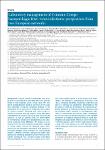Laboratory management of Crimean-Congo haemorrhagic fever virus infections: perspectives from two European networks
Bartolini, Barbara
Gruber, Cesare E. M.
Koopmans, Marion
Avšič, Tatjana
Bino, Sylvia
Christova, Iva
Grunow, Roland
Hewson, Roger
Korukluoglu, Gulay
Menel Lemos, Cinthia
Mirazimi, Ali
Papa, Anna
Paz Sanchez-Seco, Maria
Sauer, Aisha V.
Zeller, Hervè
Nisii, Carla
Capobianchi, Maria R.
Ippolito, Giuseppe
Reusken, Chantal B.
Di Caro, Antonino
Background
Crimean-Congo haemorrhagic fever virus (CCHFV) is considered an emerging infectious disease threat in the European Union. Since 2000, the incidence and geographic range of confirmed CCHF cases have markedly increased, following changes in the distribution of its main vector, Hyalomma ticks.
Aims
To review scientific literature and collect experts’ opinion to analyse relevant aspects of the laboratory management of human CCHF cases and any exposed contacts, as well as identify areas for advancement of international collaborative preparedness and laboratory response plans.
Methods
We conducted a literature review on CCHF molecular diagnostics through an online search. Further, we obtained expert opinions on the key laboratory aspects of CCHF diagnosis. Consulted experts were members of two European projects, EMERGE (Efficient response to highly dangerous and emerging pathogens at EU level) and EVD-LabNet (Emerging Viral Diseases-Expert Laboratory Network).
Results
Consensus was reached on relevant and controversial aspects of CCHF disease with implications for laboratory management of human CCHF cases, including biosafety, diagnostic algorithm and advice to improve lab capabilities. Knowledge on the diffusion of CCHF can be obtained by promoting syndromic approach to infectious diseases diagnosis and by including CCHFV infection in the diagnostic algorithm of severe fevers of unknown origin.
Conclusion
No effective vaccine and/or therapeutics are available at present so outbreak response relies on rapid identification and appropriate infection control measures. Frontline hospitals and reference laboratories have a crucial role in the response to a CCHF outbreak, which should integrate laboratory, clinical and public health responses.
Dateien zu dieser Publikation

